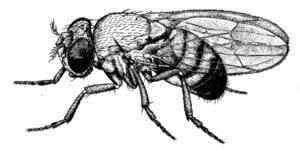Nobel Prize laureates speaking at Nobel Prize Inspiration Initiative events are united in the belief that they could not have achieved great things alone. They thank their family, friends, mentors, patients, colleagues … and not just the human ones.
When medicine laureate Michael Young spoke to students at an event in China, he expanded his acknowledgements to include his oldest colleague, Drosophila. Thanks to Drosophila fruit flies, he produced insights with profound implications for our understanding of physiology and for human medicine.
The chances are that you will be familiar with Drosophila flies from your kitchen. These tiny insects have a long association with humans, benefitting from the fruit we grow and store. There are over 1,500 species of Drosophila, and one of these is among biomedical science’s most important model organisms. Drosophila melanogaster is used in laboratories around the world, and has been integral to the work of many Nobel Prize laureates.

Drosophila has many advantages in the lab. It has short generation times, and is cheap and easy to rear. In fact, Drosophila is so easy to culture that they have even been bred on a space shuttle to help understand how space travel might affect the human immune system.
Its long history in research began around the turn of the twentieth century. One of the pioneers to see its potential was Thomas Hunt Morgan, who received the 1933 Nobel Prize in Physiology or Medicine.
He was dissatisfied with genetic theories developing in the first decade of the twentieth century and wanted to discover how traits were inherited. Funding for basic research was tight, so he searched for an animal that could be studied cheaply. Drosophila provided the answer. A visible mutation allowed Morgan to observe the succession of genetic traits through generations of flies. In this way he proved that chromosomes are the bearers of the hereditary factors which we now know as genes.
This early work paved the way for later breakthroughs, and the power of Drosophila grew as more mutations were discovered. For Jules Hoffmann, recipient of the 2011 Nobel Prize in Physiology or Medicine, mutant flies allowed him to explore activation of the innate immune system.
In particular, he gained insights from flies with mutations in the Toll gene, which was already known to be important in embryonic development. Hoffmann and his group infected these mutant flies with a fungal pathogen, and found they were more susceptible to infection than normal flies. The mutant flies were dying because they couldn’t mount an effective defence against infectious microorganisms. It appeared that the Toll signalling pathway acts as a sensor, detecting pathogens and prompting the immune system to produce antimicrobial peptides.
Meanwhile, his co-laureate Bruce Beutler was searching for a receptor for the bacterial product that causes septic shock in humans, a life-threatening condition involving overstimulation of the immune system. Remarkably, the receptor turned out to be similar to the Toll gene which Hoffmann had discovered in the fruit fly. These findings showed that mammals and fruit flies use similar molecules to activate innate immunity, the first line of defence against pathogenic microorganisms.
These ground-breaking discoveries were the subject of Nobel Prize Inspiration Initiative lectures by Hoffmann and Beutler. They tell a remarkable story of how basic research on a fly has opened up new avenues for the prevention and treatment of infections, cancer and inflammatory diseases. Although humans and fruit flies diverged from a common ancestor 800 million years ago, many components of the innate immune system have been conserved during evolution.
The remarkable similarity between the fruit fly and humans was also revealed by the work of the 2017 Nobel Prize laureates in physiology or medicine. Jeffrey C. Hall, Michael Rosbash and Michael W. Young used Drosophila to uncover molecular mechanisms controlling the circadian rhythm. Their discoveries explain how living organisms synchronise their biological rhythm with the turning of the Earth.
Since the laureates’ findings in Drosophila, it has become clear that biological clocks function by the same principles in other multicellular organisms, including plants, insects and humans. Within our bodies, there are molecular clocks present in the vast majority of tissues and cell types. Our inner clock adapts our physiology to the different phases of the day, regulating critical functions such as behaviour, hormone levels, sleep, body temperature and metabolism. The clock therefore has huge implications for our physical and mental health, as Young explained during his Nobel Prize Inspiration Initiative lecture.
These are just a few of the many stories of research on invertebrates that led to discoveries worthy of the Nobel Prize. Alongside Drosophila, other prizes have come from work on Caenorhabditis elegans – a microscopic worm. This shares some of the advantages of fruit flies, for example its short lifecycle and the ease with which it can be cultured. It also has some different properties, most notably that it is transparent. For Nobel Prize laureate Martin Chalfie, this was key to his realisation that green fluorescent protein (GFP) could be used to see cells within a living organism.
As he explained during his trip to Brazil with the Nobel Prize Inspiration Initiative, his work on this tiny worm led to GFP becoming a tool that changed biological research. Yet again, human medicine had been changed by work done on a tiny invertebrate.
These videos were filmed at Nobel Prize Inspiration Initiative events delivered in partnership with AstraZeneca.
First published in February 2020